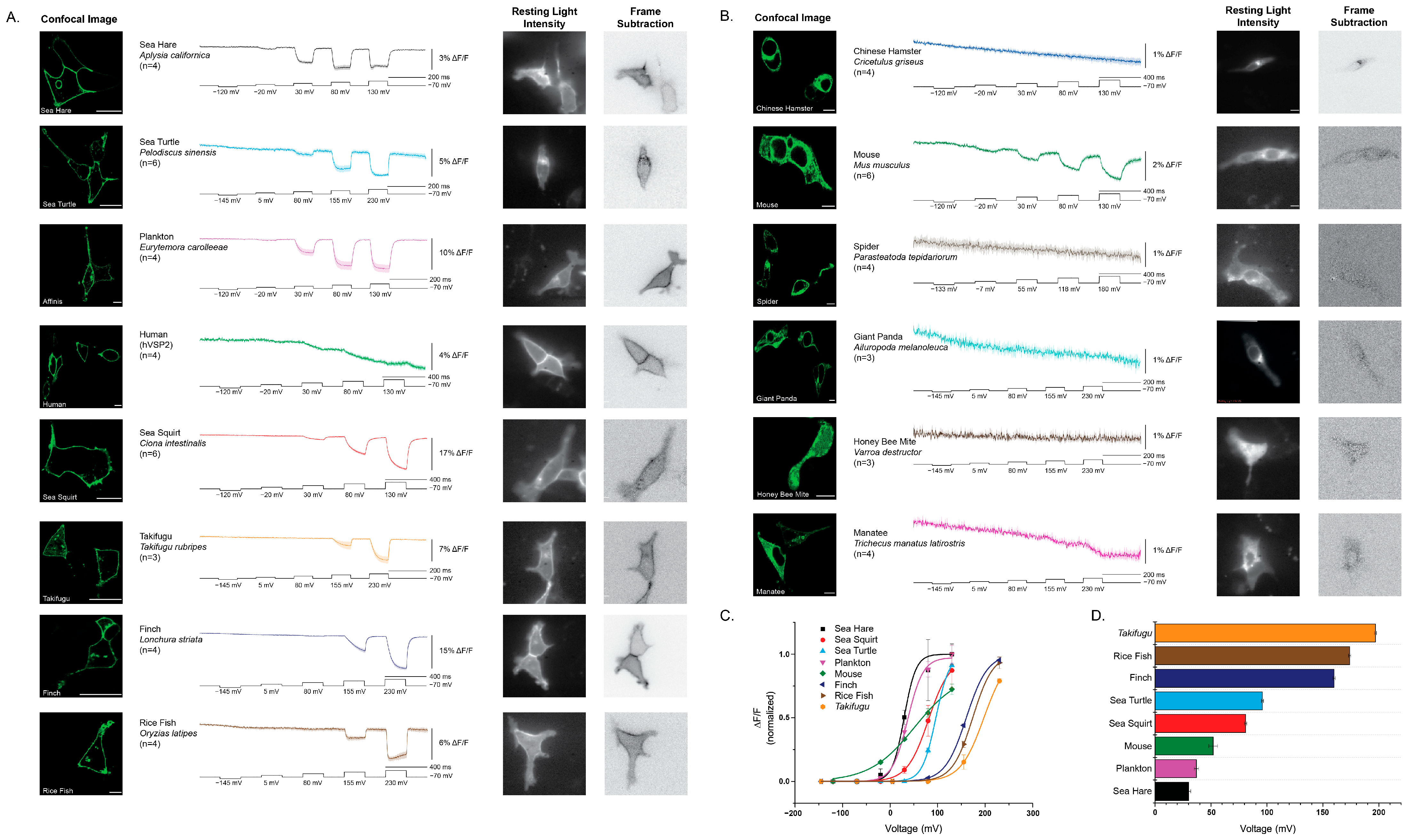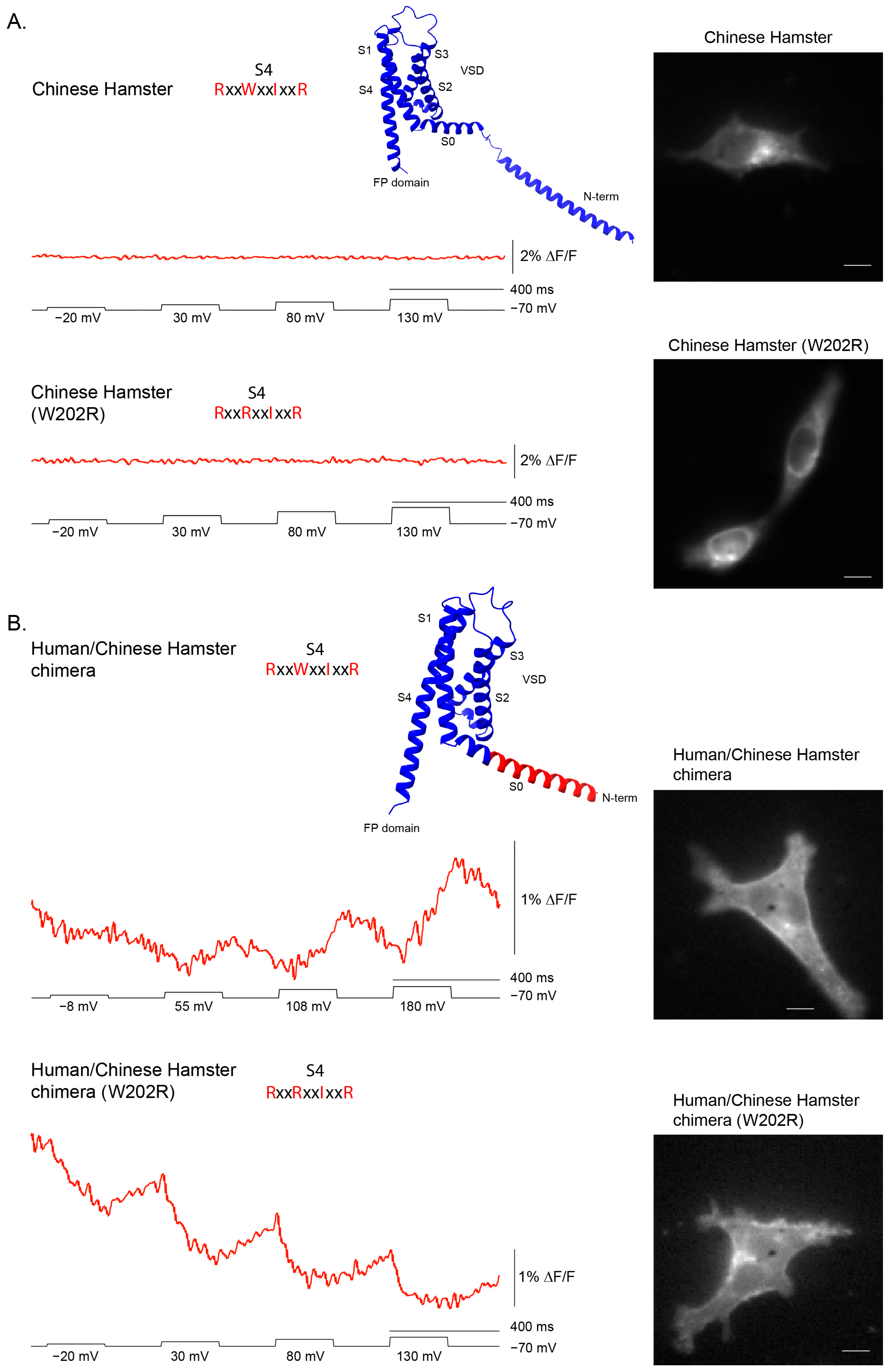From Plankton to Primates: How VSP Sequence Diversity Shapes Voltage Sensing
Abstract
1. Introduction
2. Results
2.1. Exploring Sequence Diversity in the VSD of the VSP Gene Family
2.2. Expression and Trafficking of VSP–FP Chimeras Were Highly Variable Across Species
2.3. The VSD Is Responsible for the Voltage-Dependent Optical Signal
2.4. Reverting a Primate-Specific Mutation in S1 Partially Recovers the Repolarization Signal in the Human VSD
2.5. A Divergent S4 Sequence with Only Two Sensing Charges Was Still Capable of Yielding a Voltage-Dependent Signal
3. Discussion
4. Materials and Methods
4.1. In Silico Search Strategy
4.2. Plasmid Design and Construction
4.3. Cell Culture and Transfection
4.4. Electrophysiology
4.5. Fluorescence Microscopy of Cultured Cells
4.6. Confocal Microscopy
4.7. Molecular Structure Models
Supplementary Materials
Author Contributions
Funding
Institutional Review Board Statement
Informed Consent Statement
Data Availability Statement
Acknowledgments
Conflicts of Interest
Abbreviations
| VSP | Voltage-sensing phosphatase |
| VSD | Voltage-sensing domain |
| FP | Fluorescent protein |
| GEVI | Genetically encoded voltage indicator |
References
- Rhee, J.K.; Iwamoto, Y.; Baker, B.J. Visualizing Oscillations in Brain Slices With Genetically Encoded Voltage Indicators. Front. Neuroanat. 2021, 15, 741711. [Google Scholar] [CrossRef] [PubMed]
- Bando, Y.; Sakamoto, M.; Kim, S.; Ayzenshtat, I.; Yuste, R. Comparative Evaluation of Genetically Encoded Voltage Indicators. Cell Rep. 2019, 26, 802–813.e4. [Google Scholar] [CrossRef] [PubMed]
- Jin, L.; Han, Z.; Platisa, J.; Wooltorton, J.R.; Cohen, L.B.; Pieribone, V.A. Single action potentials and subthreshold electrical events imaged in neurons with a fluorescent protein voltage probe. Neuron 2012, 75, 779–785. [Google Scholar] [CrossRef]
- Platisa, J.; Vasan, G.; Yang, A.; Pieribone, V.A. Directed Evolution of Key Residues in Fluorescent Protein Inverses the Polarity of Voltage Sensitivity in the Genetically Encoded Indicator ArcLight. ACS Chem. Neurosci. 2017, 8, 513–523. [Google Scholar] [CrossRef]
- Lee, S.; Geiller, T.; Jung, A.; Nakajima, R.; Song, Y.K.; Baker, B.J. Improving a genetically encoded voltage indicator by modifying the cytoplasmic charge composition. Sci. Rep. 2017, 7, 8286. [Google Scholar] [CrossRef]
- Murata, Y.; Iwasaki, H.; Sasaki, M.; Inaba, K.; Okamura, Y. Phosphoinositide phosphatase activity coupled to an intrinsic voltage sensor. Nature 2005, 435, 1239–1243. [Google Scholar] [CrossRef]
- Piao, H.H.; Rajakumar, D.; Kang, B.E.; Kim, E.H.; Baker, B.J. Combinatorial mutagenesis of the voltage-sensing domain enables the optical resolution of action potentials firing at 60 Hz by a genetically encoded fluorescent sensor of membrane potential. J. Neurosci. 2015, 35, 372–385. [Google Scholar] [CrossRef]
- Rhee, J.K.; Leong, L.M.; Mukim, M.S.I.; Kang, B.E.; Lee, S.; Bilbao-Broch, L.; Baker, B.J. Biophysical Parameters of GEVIs: Considerations for Imaging Voltage. Biophys. J. 2020, 119, 1–8. [Google Scholar] [CrossRef]
- Okamura, Y.; Kawanabe, A.; Kawai, T. Voltage-Sensing Phosphatases: Biophysics, Physiology, and Molecular Engineering. Physiol. Rev. 2018, 98, 2097–2131. [Google Scholar] [CrossRef] [PubMed]
- Halaszovich, C.R.; Leitner, M.G.; Mavrantoni, A.; Le, A.; Frezza, L.; Feuer, A.; Schreiber, D.N.; Villalba-Galea, C.A.; Oliver, D. A human phospholipid phosphatase activated by a transmembrane control module. J. Lipid Res. 2012, 53, 2266–2274. [Google Scholar] [CrossRef]
- Dimitrov, D.; He, Y.; Mutoh, H.; Baker, B.J.; Cohen, L.; Akemann, W.; Knopfel, T. Engineering and characterization of an enhanced fluorescent protein voltage sensor. PLoS ONE 2007, 2, e440. [Google Scholar] [CrossRef]
- Kohout, S.C.; Ulbrich, M.H.; Bell, S.C.; Isacoff, E.Y. Subunit organization and functional transitions in Ci-VSP. Nat. Struct. Mol. Biol. 2008, 15, 106–108. [Google Scholar] [CrossRef]
- Li, Q.; Wanderling, S.; Paduch, M.; Medovoy, D.; Singharoy, A.; McGreevy, R.; Villalba-Galea, C.A.; Hulse, R.E.; Roux, B.; Schulten, K.; et al. Structural mechanism of voltage-dependent gating in an isolated voltage-sensing domain. Nat. Struct. Mol. Biol. 2014, 21, 244–252. [Google Scholar] [CrossRef] [PubMed]
- Abramson, J.; Adler, J.; Dunger, J.; Evans, R.; Green, T.; Pritzel, A.; Ronneberger, O.; Willmore, L.; Ballard, A.J.; Bambrick, J.; et al. Accurate structure prediction of biomolecular interactions with AlphaFold 3. Nature 2024, 630, 493–500. [Google Scholar] [CrossRef] [PubMed]
- Crooks, G.E.; Hon, G.; Chandonia, J.M.; Brenner, S.E. WebLogo: A sequence logo generator. Genome Res. 2004, 14, 1188–1190. [Google Scholar] [CrossRef]
- Leong, L.M.; Shin, S.C.; Frankiv, N.; Rhee, J.K.; Kim, H.; Seong, J.; Woo, J.; Han, K.; Storace, D.A.; Baker, B.J. Modulating Chromophore Flexibility in GEVIs through Threonine-Based Molecular Switches Reveals an Influence of Membrane Curvature on Protein Activity. ACS Sens. 2025. [Google Scholar] [CrossRef]
- Rayaprolu, V.; Royal, P.; Stengel, K.; Sandoz, G.; Kohout, S.C. Dimerization of the voltage-sensing phosphatase controls its voltage-sensing and catalytic activity. J. Gen. Physiol. 2018, 150, 683–696. [Google Scholar] [CrossRef]
- Leong, L.M.; Kang, B.E.; Baker, B.J. Improving the flexibility of Genetically Encoded Voltage Indicators via intermolecular FRET. Biophys. J. 2021, 120, 1927–1941. [Google Scholar] [CrossRef]
- Shaikh, I.G.; Kostritskii, A.Y.; Renigunta, A.; Jeschke, J.; Halaszovich, C.R.; Zhao, W.; Geissler, M.; Bhushan, S.; Weber, S.; Meinhardt, A.; et al. Electrochemical coupling at the plasma membrane by mouse voltage-sensitive phosphatase requires association with basigin. Cell Rep. 2025, 44, 116200. [Google Scholar] [CrossRef] [PubMed]
- Rayaprolu, V.; Miettinen, H.M.; Baker, W.D.; Young, V.C.; Fisher, M.; Mueller, G.; Rankin, W.O.; Kelley, J.T.; Ratzan, W.J.; Leong, L.M.; et al. Hydrophobic residues in S1 modulate enzymatic function and voltage sensing in voltage-sensing phosphatase. J. Gen. Physiol. 2024, 156, e202313467. [Google Scholar] [CrossRef]
- Kohout, S.C.; Bell, S.C.; Liu, L.; Xu, Q.; Minor, D.L., Jr.; Isacoff, E.Y. Electrochemical coupling in the voltage-dependent phosphatase Ci-VSP. Nat. Chem. Biol. 2010, 6, 369–375, Correction in Nat. Chem. Biol. 2010, 6, 782. [Google Scholar] [CrossRef]
- Mizutani, N.; Kawanabe, A.; Jinno, Y.; Narita, H.; Yonezawa, T.; Nakagawa, A.; Okamura, Y. Interaction between S4 and the phosphatase domain mediates electrochemical coupling in voltage-sensing phosphatase (VSP). Proc. Natl. Acad. Sci. USA 2022, 119, e2200364119. [Google Scholar] [CrossRef]
- Hao, Y.A.; Lee, S.; Roth, R.H.; Natale, S.; Gomez, L.; Taxidis, J.; O’Neill, P.S.; Villette, V.; Bradley, J.; Wang, Z.; et al. A fast and responsive voltage indicator with enhanced sensitivity for unitary synaptic events. Neuron 2024, 112, 3680–3696.e8. [Google Scholar] [CrossRef] [PubMed]
- Lee, S.; Kang, B.E.; Song, Y.-K.; Baker, B.J. A trafficking motif alters GEVI activity implicating persistent protein interactions at the membrane. Biophys. Rep. 2022, 2, 100047. [Google Scholar] [CrossRef] [PubMed]
- Altschul, S.F.; Madden, T.L.; Schaffer, A.A.; Zhang, J.; Zhang, Z.; Miller, W.; Lipman, D.J. Gapped BLAST and PSI-BLAST: A new generation of protein database search programs. Nucleic Acids Res. 1997, 25, 3389–3402. [Google Scholar] [CrossRef]
- Madeira, F.; Madhusoodanan, N.; Lee, J.; Eusebi, A.; Niewielska, A.; Tivey, A.R.N.; Lopez, R.; Butcher, S. The EMBL-EBI Job Dispatcher sequence analysis tools framework in 2024. Nucleic Acids Res. 2024, 52, W521–W525. [Google Scholar] [CrossRef] [PubMed]
- Pettersen, E.F.; Goddard, T.D.; Huang, C.C.; Couch, G.S.; Greenblatt, D.M.; Meng, E.C.; Ferrin, T.E. UCSF Chimera--a visualization system for exploratory research and analysis. J. Comput. Chem. 2004, 25, 1605–1612. [Google Scholar] [CrossRef]





| Species | Tau On (ms) | Tau Off (ms) | V1/2 (mV) | Largest ΔF/F |
|---|---|---|---|---|
| Sea Hare | 12.8 ± 1.2 | 9.6 ± 0.2 | 26.3 ± 2.9 | 3%/150 mV |
| Sea Turtle | 30.1 ± 0.3 | 11.5 ± 1.4 | 85.2 ± 0.4 | 4.5%/300 mV |
| Rice Fish | 7.9 ± 0.2 | 3.8 ± 0.1 | >150 | 5.8%/300 mV |
| Plankton | 8.7 ± 1.1 | 13 ± 0.3 | 37.9 ± 1.5 | 9.7%/200 mV |
| Finch | 49.3 ± 1.7 | 9.1 ± 1.0 (fast—68.5%) | >160 | 15%/300 mV |
| 35.4 ± 1.1 (slow—31.5%) | ||||
| Sea Squirt | 20.7 ± 0.7 (fast—51%) | 15.9 ± 0.4 (fast—87%) | 80.7 ± 1.7 | 15.5%/200 mV |
| 103.3 ± 8.5 (slow—49%) | 133.1 ± 31 (slow—13%) | |||
| Mouse | 67.6 ± 3.1 | 37.3 ± 1.5 | 56.2 ± 3.6 | 1.8%/200 mV |
| Takafugu | 30.8 ± 1.9 | 6.75 ± 0.1 | >190 | 6.5%/300 mV |
| Human | 131.6 ± 3.0 | N.D. | N.D. | 2.5%/150 mV |
Disclaimer/Publisher’s Note: The statements, opinions and data contained in all publications are solely those of the individual author(s) and contributor(s) and not of MDPI and/or the editor(s). MDPI and/or the editor(s) disclaim responsibility for any injury to people or property resulting from any ideas, methods, instructions or products referred to in the content. |
© 2025 by the authors. Licensee MDPI, Basel, Switzerland. This article is an open access article distributed under the terms and conditions of the Creative Commons Attribution (CC BY) license (https://creativecommons.org/licenses/by/4.0/).
Share and Cite
Leong, L.M.; Kim, Y.; Baker, B.J. From Plankton to Primates: How VSP Sequence Diversity Shapes Voltage Sensing. Int. J. Mol. Sci. 2025, 26, 10963. https://doi.org/10.3390/ijms262210963
Leong LM, Kim Y, Baker BJ. From Plankton to Primates: How VSP Sequence Diversity Shapes Voltage Sensing. International Journal of Molecular Sciences. 2025; 26(22):10963. https://doi.org/10.3390/ijms262210963
Chicago/Turabian StyleLeong, Lee Min, Youna Kim, and Bradley J. Baker. 2025. "From Plankton to Primates: How VSP Sequence Diversity Shapes Voltage Sensing" International Journal of Molecular Sciences 26, no. 22: 10963. https://doi.org/10.3390/ijms262210963
APA StyleLeong, L. M., Kim, Y., & Baker, B. J. (2025). From Plankton to Primates: How VSP Sequence Diversity Shapes Voltage Sensing. International Journal of Molecular Sciences, 26(22), 10963. https://doi.org/10.3390/ijms262210963






